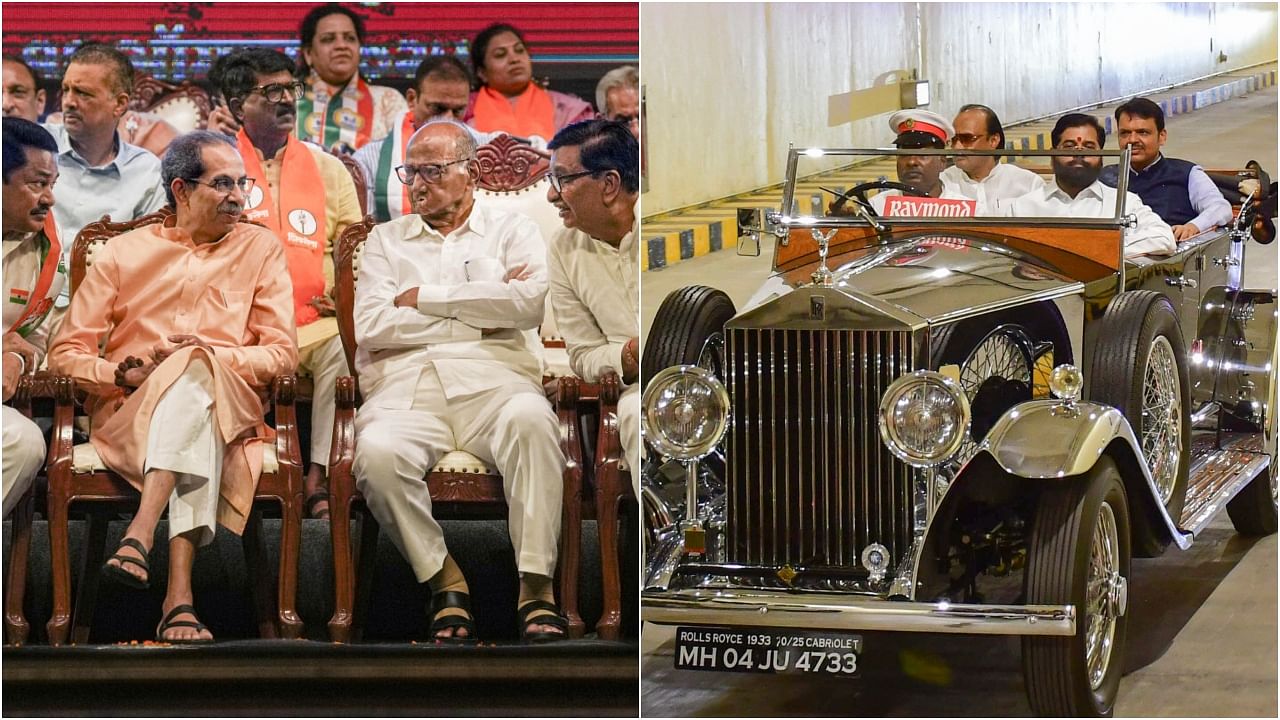
Maharashtra Congress chief Nana Patole, Shiv Sena (UBT) chief Uddhav Thackeray, NCP (SP) chief Sharad Pawar and Congress leader Balasaheb Thorat (L); Maharashtra CM Eknath Shinde with his deputies Devendra Fadnavis and Ajit Pawar.
Credit: PTI Photos
Mumbai: Years from now, the 14th Maharashtra Legislative Assembly will be remembered as one of the most tumultuous in the western Indian state as it saw an unprecedented three Chief Ministers, three Leaders of the Opposition, two Speakers, and two mega-splits in prominent parties - Shiv Sena and the Nationalist Congress Party (NCP).
The tenure of the current Assembly ends on 26 November, 2024.
The three Chief Ministers that the House witnessed are - Devendra Fadnavis (BJP) for barely 80 hours, Uddhav Thackeray (Shiv Sena) for around two-and-a-half-years and incumbent Eknath Shinde (Shiv Sena), for the remaining two-and-a-half years.
The Leaders of the Opposition in Assembly included Devendra Fadnavis (BJP), Ajit Pawar (NCP), and Vijay Wadettiwar (Congress).
NCP’s Ajit Pawar created a sort of record in Indian politics by becoming the Deputy Chief Minister thrice - of his total five terms as No 2 - during the tenure of the Assembly serving under three different Chief Ministers.
Fadnavis, who was the Chief Minister and also served as Leader of the Opposition, was virtually pushed by the BJP high-command to become a Deputy Chief Minister.
The two Speakers that the House saw are Nana Patole (Congress) and Rahul Narvekar (BJP).
Despite the see-saw, the Deputy Speaker remained unchanged for five years - NCP's Narhari Zirwal.
The results of the last Vidhan Sabha polls were announced on 24 October 2019, and from that very day politics changed its course drastically in Maharashtra.
In the run up to the 15th Assembly polls, a similar suspense looms over the state's political climate with no clarity on permutations and combinations that may develop after the EVMs declare the outcome.
Interestingly, coinciding with the tenure of the Assembly, the state also saw three Governors - Bhagat Singh Koshyari (5 September 2019-17 February 2024), Ramesh Bais (18 February 2023-30 July 2024), and incumbent C P Radhakrishnan, who took over on 31 July 2024.
For a quarter of a century, Maharashtra's political games were mainly played between two distinct coalitions - the Shiv Sena-BJP saffron alliance called Maha Yuti and Congress-NCP Democratic Front.
While the Shiv Sena-BJP government was in power from 1995-99, it failed to retain its hold, resulting in the Democratic Front ruling the state from 1999 to 2014 - for three successive terms.
However, in 2014, before the 13th Maharashtra Legislative Assembly polls, both the alliances broke down and the four parties tested waters on their own strengths.
Riding the crest of the Narendra Modi-wave, the BJP emerged as the No.1 party and secured the outside support of Sharad Pawar to form the government at that time - with Fadnavis taking over the top job.
Thackeray chose Shinde to be the Leader of the Opposition.
Barely a couple of months later, the Shiv Sena joined the BJP government and Sharad Pawar moved to the Opposition.
However, Fadnavis, then Chief Minister, taught a lesson to the Shiv Sena by denying it the post of Deputy Chief Minister and important portfolios.
This naturally rattled Thackeray, whose party appeared to function like an opposition within the government.
In 2019, the peeved Thackeray was in no mood to have any truck with BJP, but the saffron party’s troubleshooter Amit Shah came down to Mumbai and attempted to mollify him.
As the state threw up a fractured mandate with BJP’s numbers dwindling, a wily Sharad Pawar sensed a kill.
He got up to play a key role to expand the Democratic Front into a marquee anti-BJP grouping - Maha Vikas Aghadi, roping in the Shiv Sena - upsetting all calculations of the BJP.
Resultantly, the 30-year-old saffron alliance—built by the BJP and Shiv Sena founder Balasaheb Thackeray—crashed into pieces.
However, forming the government was no easy task, and in an early-morning political coup, 'Operation Kamala', Fadnavis became the Chief Minister for the second time and Ajit Pawar his deputy.
However, as the Supreme Court stepped in and Ajit Pawar could not muster the requisite support of the NCP MLAs, the Fadnavis-Ajit Pawar government collapsed in a span of 80 hours.
However, at the insistence of Pawar, Thackeray became the ‘reluctant’ Chief Minister on November 28, 2019 at a grand public ceremony.
Then came the Covid-19 pandemic - which compounded the political problems of the MVA with a belligerent BJP plus Fadnavis breathing down Thackeray’s neck daily.
Fadnavis, the state BJP strongman, could not digest the fact that the CM’s post had slipped out of his hands - and the saffron party made every attempt to destabilize the MVA.
However, success came in June-July 2022 and June-July 2023, when the BJP engineered splits in the Shiv Sena and NCP, respectively, completely changing the political dynamics of the state.
Shinde, a minister in the Thackeray government, silently rebelled and after a series of multi-state machinations, went on to become the ‘surprise’ CM.
A year later, Ajit Pawar followed suit after raising a banner of revolt against his own uncle and mentor Sharad Pawar.
Uddhav Thackeray and Sharad Pawar now command the Shiv Sena (UBT) and NCP (SP), respectively, are key allies of the Congress-led I.N.D.I.A. opposition bloc.
They lost their symbols and now have a ‘flaming torch’ and ‘man blowing turari’, while Shinde commands ‘bow and arrow’ and Ajit Pawar the ‘clock’ symbol.
Nevertheless, if the results of the 2024 Lok Sabha polls in Maharashtra are any indicators, the bag of surprises is far from empty yet.